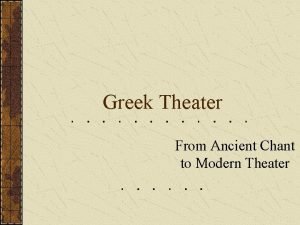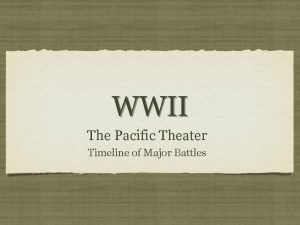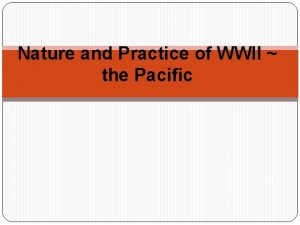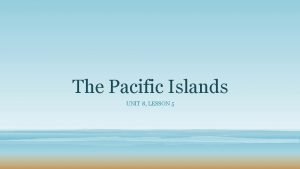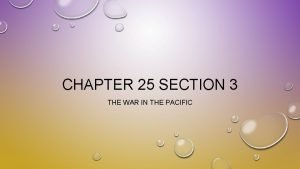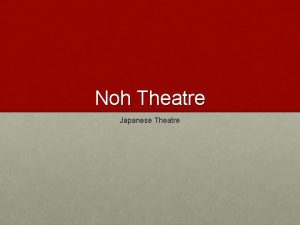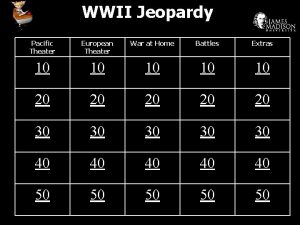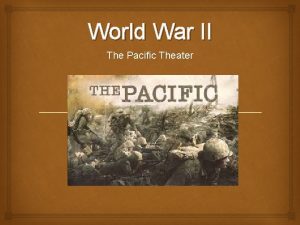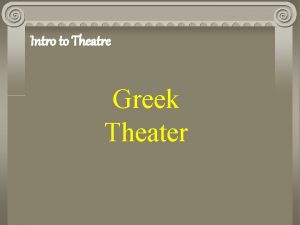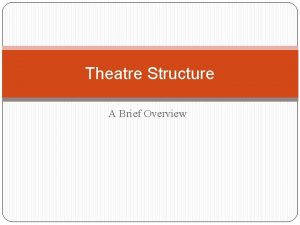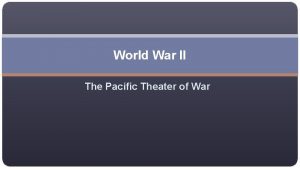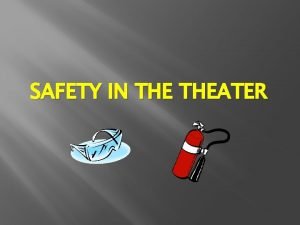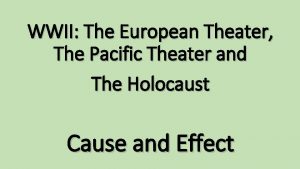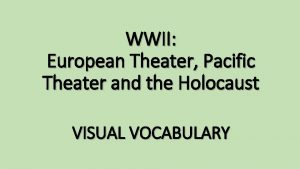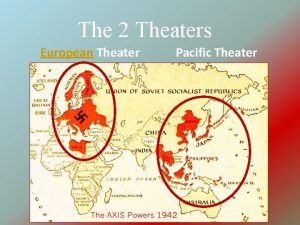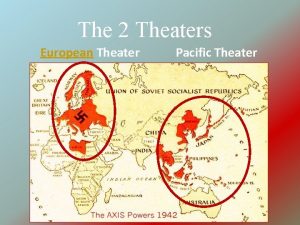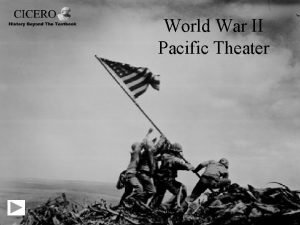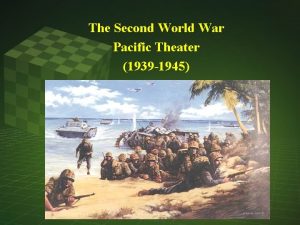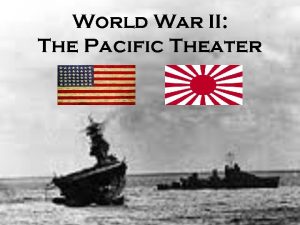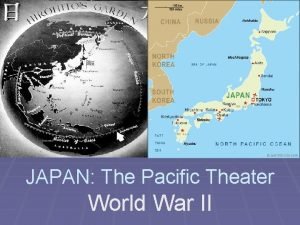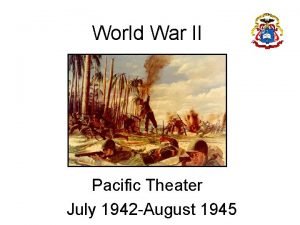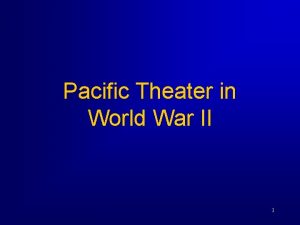World War II PACIFIC THEATRE The Pacific Theater

































- Slides: 33

World War II PACIFIC THEATRE

The Pacific Theater

Okinawa Iwo Jima Guam Coral Sea Midway

Doolittle Raid FDR wanted to quickly attack Japan as after Pearl Harbor to boost American morale. Surprise mission…even to our people. Couldn’t get typical bombers close to Japan so we launched 16 B-25 Bombers from an aircraft carrier. PROBLEM: Couldn’t land on an aircraft carrier SOLUTION: Land in China …but no B-25 s made it. Seven Americans lives lost. Little damage done to Tokyo. Psychological victory for US and embarrassment for Japan.

The Philippines December 9, 1941 Days after the Pearl Harbor attack, Japanese landed troops in the Philippines. After four months the US surrendered. FDR ordered Gen. Douglas Mac. Arthur (Supreme Commander of Pacific Fleet) to evacuate to Australia. Mac. Arthur vowed, “I came through, I shall return. ”

Bataan Death March 12, 000 American soldiers surrendered 76, 000 American and Filipino troops sent to prison camps by way of a “Death March” • • 65 mile walk Took a week with very little food or water 90 degree heat and nearly 100% humidity Bayoneted or shot if you fell or got out of line • Thousands died along the trip…left on road for all to see • Bodies were flattened by trucks and tanks • Near end there was a train ride • More died from suffocation in the boxcars

Thousands walked to prison camp for 6 days in 90 degree weather A number of men were beheaded on walk Some lucky sick were carried by other troops

Prison Camp 3 ½ years in Prison Camp. One spicket of water in camp. With 7, 000 prisoners, some stood in line 6 -10 hrs for drink Prisoners were strung up by thumbs Sun Treatment: Sit in sun all day – No water Up to 450 died per day in camp

Prisoners strung up by thumbs

Malnutrition and disease from human waste killed thousands

Coral Sea May, 1942 US broke Japanese codes and learned of their plan to attack New Guinea, near Australia Admiral Nimitz sent two aircraft carriers to intercept. • Big air battle where both sides lost a number of ships. • Japan inflicted greater damage to US fleet • US was able to prevent Japan from taking New Guinea • US kept supply lines open to Australia

Battle of Midway June, 1942 US learned of Japanese attack on Midway island, near Hawaii. Admiral Nimitz again set up an ambush. Within three minutes the Japanese lost three aircraft carriers… and a fourth was sunk a few hours later. Japanese fleet was crippled and they stopped their advances in the Pacific KEY TURNING POINT OF WAR

Three Japanese Aircraft Carriers sunk at Battle of Midway

Island Hopping Nov 1943 – June 1945 After Midway and the Japanese stopped advancing in the Pacific, the US put together a strategy to defeat Japan 1) Admiral Nimitz would start a campaign through the central pacific – “island hopping” to get closer and closer to Japan

Island Hopping Nov 1943 – June 1945 The MARIANA ISLANDS: Saipan – Guam - Tinian SAIPAN: Difficult battle through mountains and caves. Many Japanese jumped off cliffs rather than surrender US - 14, 111 Japan - 31, 000 View video on my website – parts might be hard to watch Add additional notes from video to your note guide GUAM – TINIAN Much easier battles. Two weeks in Guam, only 6 days on Tinian

Island Hopping Nov 1943 – June 1945 2) General Mac. Arthur advanced through the South Pacific to take back the Philippines. (Remember FDR ordered Mac. Arthur out of this territory before the Bataan Death March and he famously said, “I came through, I shall return. ” see slide 5 again if needed!)

Philippines (part 2) October 1944 Gen. Mac. Arthur – “I Have Returned” US forces invade the Philippines with 160, 000 troops on 700 ships. They land in the Leyte Gulf. Japanese forces sent four aircraft carriers to intercept and secretly send another fleet to ambush US from the other side

Battle of Leyte Gulf Spe nd min a few ute co the mpar s se n in um g ber s! October 23 -26 1944 Largest naval battle in history Large carriers Small Carriers Aircraft Battleships Cruisers Destroyers US 8 24 1712 12 24 141 Japan 1 3 617 9 20 34 Loses in the battle Large carriers Small Carriers Aircraft Battleships Cruisers Destroyers US 0 1 ? 0 2 2 Japan 1 3 500 3 10 9

Kamikaze Pilots deliberately crash planes carrying a bomb into American ships Kamikazes destroyed 36 US warships throughout the war

Philippines (part 2) October 1944 – March 1945 Battle of Philippines was a long grueling battle, first through hills and caves, then a month-long urban battle Mac. Arthur’s troops finally capture Manila in March 1945 80, 000 Japanese troops killed Less than 1, 000 surrender POWs are freed from Japanese prison camps

Iwo Jima Feb 19 – March 25 1945 US needed Iwo Jima to have a base to refuel B-29 bombers on their way to Japan Terrain was BRUTAL to fight against Japanese. Small 8 mile island that was basically one big volcano. Jagged rocks and thick volcanic ash made it difficult to climb Japanese had built a vast network of concrete bunkers in the volcano with miles of tunnels

Iwo Jima 22, 786 Japanese were on the island in the hills. Only 216 were taken prisoner - all others died. 700, 000 Marines invaded the island. 6, 821 killed in action (more than D-day) The raising of the flag is perhaps the most reproduced photograph in history The only photograph to win a Pulitzer prize the same year it was taken. View video on my website

Okinawa April 1 – June 22, 1945 US needed Okinawa as a base to prepare for invasion of Japan. A place to build up troops and stockpile weapons. Okinawa made of rugged mountains. Japanese had elaborate caves and bunkers in mountains 12, 000 US solders died over 100, 000 Japanese View video on my website You may STOP at this point!

FDR Dies April 12, 1945 Franklin Delano Roosevelt dies of a massive cerebral hemorrhage while on vacation in his Georgia retreat. His wife Eleanor is the one that told the vice president of the news. He asked her if there was anything he could do for her. She responded by saying, “Is there anything we can do for you, Harry? For you are the one in trouble now. ” Truman appreciated that the best way to reassure the country and build public support for himself was by demonstrating his determination to fulfill Roosevelt's stated wartime and postwar plans. Harry S. Truman

Japanese Invasion ? ! October, 1945 Operation Downfall The invasion of Japan scheduled to begin in October of 1945. The invasion will use the combined forces of General Mac. Arthur’s and Admiral Nimitz’ naval, air, and ground forces. As the Japanese have proven surrender was a very difficult proposition for them, it was predicted that casualties for the assault would be in the millions for America and tens of millions for Japan…. including civilians Truman contemplated another weapon at his disposal….

Manhattan Project Since 1938, when scientist learned to split the atom, there was a fear that work was being done to create an atomic weapon…by Germany. In 1939 Albert Einstein personally sent a letter to FDR urging him to build a bomb before Hitler could have one built … a decision Einstein later says was his only regret in life. In 1941, the US secretly began work on an atomic bomb. This project was code named “the Manhattan Project” It was so secretive that FDR, unbelievably, never told Truman, his Vice President.

Truman’s toughest decision? Arguments for and against dropping the bomb FOR AGAINST Save American lives Civilian Casualties Japan will NOT surrender Radiation worse than conventional bombs Show Soviets we had bomb Truman later wrote that he “regarded the bomb as a military weapon and never had any doubts that is should be used. ”

HIROSHIMA Hiroshima was chosen as military and industrial city Had sufficient population and was previously untouched by bomb raids to show devastation of bomb Little Boy

HIROSHIMA August 6, 1945 Bomb explodes 1, 500 feet above city. Damage from bomb was in a one mile radius. 65% of city destroyed Casualties: Estimated between 80, 000 and 120, 000 Causes of Death 60% - Burns 30% - Debris 10% - Other

BEFORE AFTER


NAGASAKI August 9, 1945 Three days later, with no surrender from the Japanese, Truman orders a second dropping of the atomic bomb This one, called Fat Man, detonates over Nagasaki Casualties: estimated between 35, 000 and 75, 000 NOTE: On this same day, prior to the bomb dropping, USSR declares war on Japan

JAPANESE SURRENDER August 15, 1945 V-J Day Japan surrenders to General Mac. Arthur aboard the USS Missouri
 Greek theater vs modern theater
Greek theater vs modern theater Pacific theater timeline
Pacific theater timeline Pacific theater
Pacific theater Civil war readers theater
Civil war readers theater Unit 8 lesson 5
Unit 8 lesson 5 Chapter 25 section 3 the war in the pacific
Chapter 25 section 3 the war in the pacific What challenges did madison face abroad
What challenges did madison face abroad Korean war vietnam war venn diagram
Korean war vietnam war venn diagram Lesson 1 the cold war begins
Lesson 1 the cold war begins Truman vs eisenhower venn diagram
Truman vs eisenhower venn diagram Was josette dugas pro war
Was josette dugas pro war Sein i datid
Sein i datid Studyjams force and motion
Studyjams force and motion Civil war first modern war
Civil war first modern war Simple past bringen
Simple past bringen Toward civil war lesson 3 secession and war
Toward civil war lesson 3 secession and war Proxy wars in the cold war
Proxy wars in the cold war Chapter 30 the war to end war
Chapter 30 the war to end war Chapter 30 the war to end war
Chapter 30 the war to end war Hát kết hợp bộ gõ cơ thể
Hát kết hợp bộ gõ cơ thể Bổ thể
Bổ thể Tỉ lệ cơ thể trẻ em
Tỉ lệ cơ thể trẻ em Voi kéo gỗ như thế nào
Voi kéo gỗ như thế nào Chụp phim tư thế worms-breton
Chụp phim tư thế worms-breton Hát lên người ơi alleluia
Hát lên người ơi alleluia Môn thể thao bắt đầu bằng từ đua
Môn thể thao bắt đầu bằng từ đua Thế nào là hệ số cao nhất
Thế nào là hệ số cao nhất Các châu lục và đại dương trên thế giới
Các châu lục và đại dương trên thế giới Cong thức tính động năng
Cong thức tính động năng Trời xanh đây là của chúng ta thể thơ
Trời xanh đây là của chúng ta thể thơ Mật thư tọa độ 5x5
Mật thư tọa độ 5x5 Phép trừ bù
Phép trừ bù Phản ứng thế ankan
Phản ứng thế ankan
